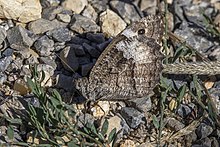| Hipparchia syriaca | |
|---|---|

| |
| H. s. syriaca, Corfu, Greece | |

| |
| H. s. cypriaca, Cyprus | |
| Scientific classification | |
| Domain: | Eukaryota |
| Kingdom: | Animalia |
| Phylum: | Arthropoda |
| Class: | Insecta |
| Order: | Lepidoptera |
| Family: | Nymphalidae |
| Genus: | Hipparchia |
| Species: | H. syriaca |
| Binomial name | |
| Hipparchia syriaca (Staudinger, 1871) | |
| Synonyms | |
| |
Hipparchia syriaca is a species of butterfly in the family Nymphalidae. It is found in Greece especially on the island of Samos, Turkey, Bulgaria, Albania, North Macedonia, Caucasus and Transcaucasia. It is found on the edges of foothills and mountain forests up to 2,000 m
Description
Very like Hipparchia hermione but the band of the forewing is narrower, being entirely obsolete in the anal area of the hindwing.
Flight period
Typically June to August, depending on altitude and locality. In Cyprus, the flight time of H. s. cypriaca is from May to October, or later.
Food plants
Larvae feed on Holcus species.
Biotope
Bushy places pine woods and clearings.
References
- Seitz, A. in Seitz. A. ed. Band 1: Abt. 1, Die Großschmetterlinge des palaearktischen Faunengebietes, Die palaearktischen Tagfalter, 1909, 379 Seiten, mit 89 kolorierten Tafeln (3470 Figuren)
 This article incorporates text from this source, which is in the public domain.
This article incorporates text from this source, which is in the public domain.
- John, Eddie, in: Sparrow, David J. and John, Eddie (Eds.) (2016). An Introduction to the Wildlife of Cyprus. Terra Cypria. ISBN 978-9963-601-45-5.
{{cite book}}: CS1 maint: multiple names: authors list (link)
Sources
- Species info
- "Hipparchia Fabricius, 1807" at Markku Savela's Lepidoptera and Some Other Life Forms
| Taxon identifiers | |
|---|---|
| Hipparchia syriaca | |
| Satyrus syriaca | |
This Satyrini article is a stub. You can help Misplaced Pages by expanding it. |